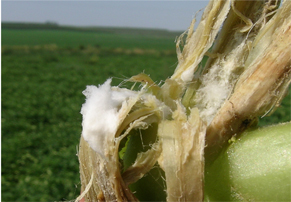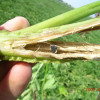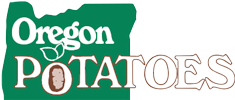White Mold
Causal Agent:
Sclerotinia sclerotiorum
Biology:
Pathogen of many crops and other plants. Survives winter and other adverse conditions such as pesticides as sclerotia in the soil. Sclerotia germinate in spring and produce tiny mushroom-like structures called apothecia, which produce ascospores that infect senescing tissues such as flowers. Infections of healthy tissue start from mycelial growth from infected dying plant tissue or directly from sclerotia in the soil.
Dispersal:
New fields can be infected by ascospores blown with the wind, but the pathogen is extremely wide spread due to its wide host range and persistence in the soil.
Management:
- White mold is most serious in fields with dense canopies, plenty of nitrogen fertilizer, and excess overhead irrigation; therefore —
*manage crop growth to limit canopy density, and
*avoid excess irrigation and long periods of leaf wetness. - Fungicide applications should be timed to coincide with full bloom of the primary flower clusters.
- See the Online Guide to Plant Disease Control for specific fungicide products here.















